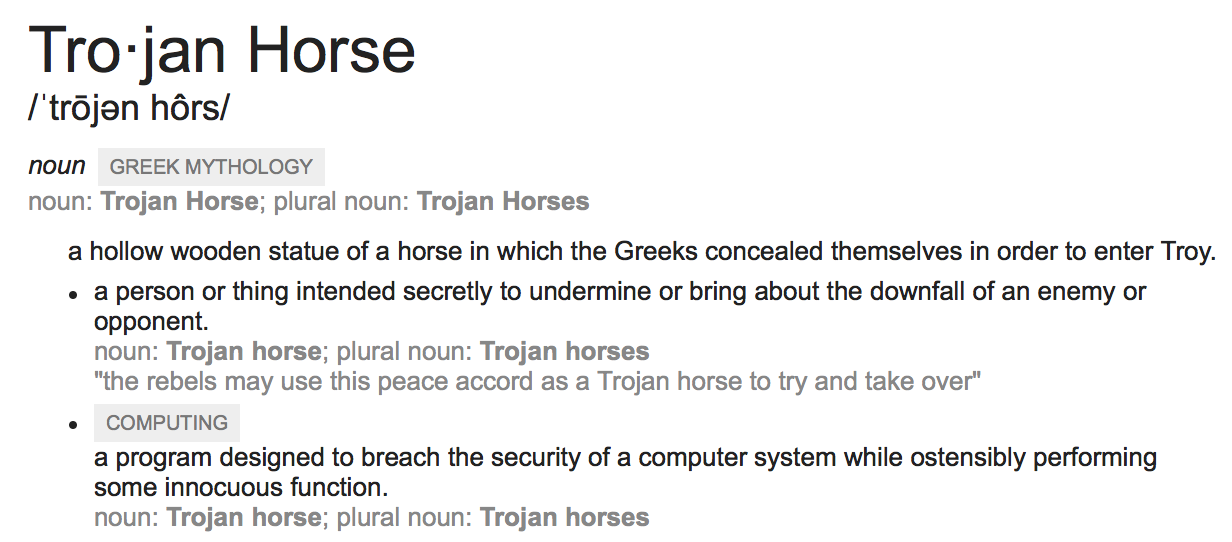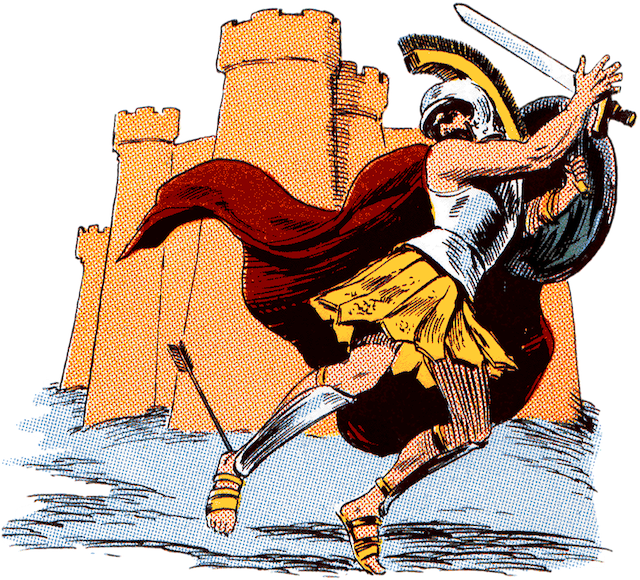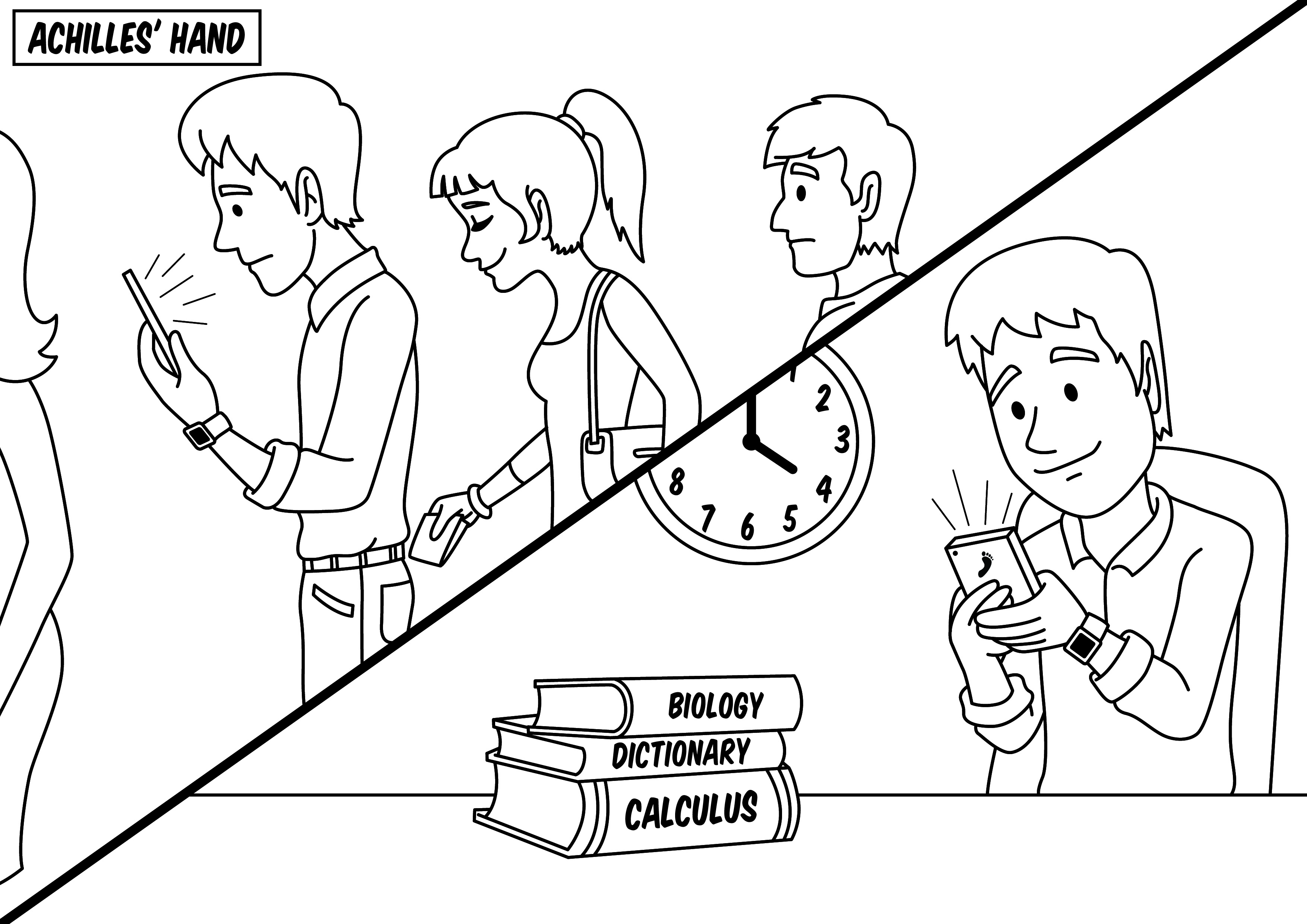4.8: Story- The Trojan War Part 3- The Wooden Horse
- Page ID
- 47148
Adapted from Stories of the Ancient Greeks by Charles D. Shaw, $\ccpd$
The brave Hector was dead, but other friends went to help Troy. One of these was Penthesilea, queen and leader of the Amazons. These were women who were brave fighters, and who did not permit any men to live in their country. The queen met death at the hands of Achilles, who was very sorry afterward.
When Achilles was a child, his mother Thetis, an immortal nymph, had dipped him in the river Styx in an attempt to make him immortal like herself, and the heel by which she had held him to dip him in the water was the only spot where he could be hurt.
During the war with Troy, Achilles had seen and loved Priam’s daughter, Polyxena. He told the Trojans that if she would marry him, he would try to make peace between them and the Greeks. While the matter was being talked over in the temple of Apollo, Paris, with a poisoned arrow, shot Achilles in the heel. He died, and Ajax and Odysseus carried back his body to the ship. His shining armor was given to Odysseus.
The Trojans had a statue of Athena which was said to have fallen from heaven. It was called the Palladium, and they believe that while it was safe among them, their city could never be taken. Odysseus and a friend went into the city one night, entered the temple, took the statue, and carried it to the Greek ships.
Even then the city stood unconquered. Odysseus thought of a plan by which it might be captured. Some of the ships were taken away and hidden behind an island. Many men worked at building a large wooden horse, which they said was to be offered to Athena. It was hollow, and a number of soldiers snuck into it, after which it was closed up and left standing in the camp.
The rest of the Greeks went on board their ships and left. The Trojans thought their enemies were gone forever. So they came out of their city and walked about, glad to be free. They went to the deserted camp of the Greeks and picked up old swords and broken helmets and other things that had been left on the ground.
Everybody wondered at the huge horse standing there. “What can be the use of that?” said some. Others said, “Let us take it into the city and put it in some temple.” Still, others declared that it would be far better not to touch it, but to leave it entirely alone.
Cassandra as well had doubts. She was the daughter of King Priam, and thus the princess of Troy. Apollo fell in love with her and begged her to spend just one night with him, and if she agreed, he promised he would give her the gift of prophecy. However, as a priestess of Apollo himself, she promised a life of celibacy. Annoyed by her strong will, Apollo punished her, saying he will give her the ability to know the future anyway, but that no one will believe her.
“Have you not already suffered enough from the fraud of our enemies? As for me, I fear the Greeks even when they bring gifts,” Cassandra warned the Trojan troops looking up at the wooden horse. She had seen visions of the men bringing the horse inside the city, and then suddenly catching on fire, the flames raging throughout the whole city.

One of the Trojan warriors threw his spear at the horse’s side. A sound like a groan followed the blow. The people were about to break and burn the horse when a crowd of men was seen dragging along a frightened Greek. His name was Sinon, and it was part of the plan that he should remain in the camp so that he might be captured by the Trojans.
The leaders asked him why he was there and what was the meaning of this horse. He told them that Odysseus had betrayed him, and had left him on shore when the rest of the Greeks went away. The horse, he said, was an offering to Athena. It had been made very large so that it might not be carried into the city. “Our prophet told us,” he added, “that if the Trojans ever took it they would surely conquer us.”
The people now thought that the horse must truly be sacred, and with much labor, and yet celebration, carried it into the city. Pulling at her hair, Cassandra could no longer deal with her curse and just stood there, watching as the singing men dragged it in. At night, Sinon, the Greek, opened the horse and let out the soldiers. He also opened the gates of the city to the other Greeks, who had come silently back.
The Trojans had gone happily to sleep, thinking it needless to keep watch because no enemy was near. They were woken by the light of a great fire. Their temples were in flames. They rushed into the streets shocked and frightened. Greek soldiers met them at their doors and showed them no mercy.
The old king Priam put on his armor so that he might fight, but the queen, Hecuba, persuaded him to go with her to the temple of Zeus and pray for help. While they were kneeling at the altar, their youngest son rushed in and fell dead at their feet. After him came the son of Achilles, Pyrrhus, who had wounded him. Priam threw his spear at this fierce enemy, but the young man struck him down beside his son.
Ilion, or Troy, was entirely destroyed. Many of the people were killed. Many more, with the old queen and her daughter, were carried away as captives. Cassandra, driven mad by her tragic powers, watched her home burn and was killed.
Paris was among the dead. Menelaus found his wife Helen, who had caused all this trouble and misery, and they went back to Sparta, their old home. The Greek leaders gathered their men who were left and set sail for the land they had not seen for ten long years. The Trojan war was over, and Troy was no more.
Comprehension Questions
Answer the following questions according to the reading.
- Who is Penthesilea?
- Why did Achilles’ mother dip him in the Styx River? (Do you remember where the Styx River is?)
- What happened to Achilles’ in the temple?
- What was Odysseus’ great idea?
- Who is Cassandra, and what did she say about the wooden horse?
- Who is Sinon?
- Why did the Trojans decide to bring the horse into the city?
- How and when did the Greeks infiltrate Troy?
- How was the king of Troy killed?
- The beginning of Part 1 mentions a prophesy. What was it and did it come true?
Thinking Critically About Vocabulary
Answer the following questions. Compare your answers with a partner.
- As you have seen, we get a lot of interesting vocabulary and idioms from this story. First, we get the word “amazon” from this story. Here’s an explanation of several meanings from the Merriam-Webster dictionary:
 According to this, what does it mean if you call a woman “an amazon”?
According to this, what does it mean if you call a woman “an amazon”? - Also we get the phrase “a Cassandra” or “Cassandra complex”. Read the following definition from Wikipedia:
The Cassandra metaphor (variously labeled the Cassandra ’syndrome’, ’complex’, ’phenomenon’, ’predicament’, ’dilemma’, or ’curse’) occurs when valid warnings or concerns are dismissed or disbelieved.
The metaphor has been applied in a variety of contexts such as psychology, environmentalism, politics, science, cinema, the corporate world, and in philosophy, and has been in circulation since at least 1949 when French philosopher Gaston Bachelard coined the term ’Cassandra Complex’ to refer to a belief that things could be known in advance. The Cassandra metaphor is applied by some psychologists to individuals who experience physical and emotional suffering as a result of distressing personal perceptions, and who are disbelieved when they attempt to share the cause of their suffering with others.
A cassandra, according to the Merriam-Webster dictionary, is “one that predicts misfortune or disaster”–someone who is pessimistic about something. Oftentimes those around them are too optimistic to believe them.
Do you have any experience being a “Cassandra”?

How is this idiom related to the story? Give an example of your Achilles’ heel.

How is this proverb related to the story? Give an example of a time when you had to “beware of Greeks bearing gifts”.

Why do you think a kind of computer virus is sometimes called a “Trojan horse”? What could be another example of something as a Trojan horse?
Analyzing Cartoons
With a classmate, discuss the meaning of the following cartoons. What topics are they talking about in the cartoons below? What do you know about the topic? How does it connect to the events of the Trojan War?
 by Gaspar Sabater $\ccbyncnd$ | |
 by Gwen Delos Santos $\ccbyncnd$ | |
Click here for more interesting cartoons to discuss:
- i2.wp.com/thenewsrep.com/wp-content/uploads/2015/09/SofRep-ISIS-EU-Trojan-Horse.jpg?w=2000&ssl=1
CEFR Level: CEF Level B1







